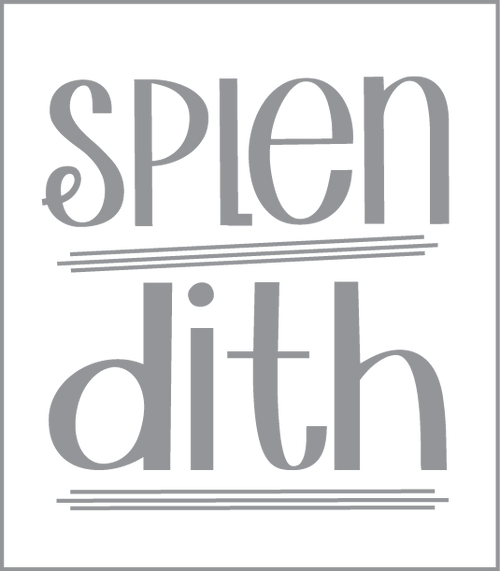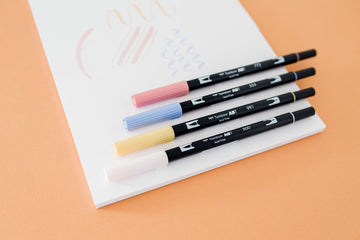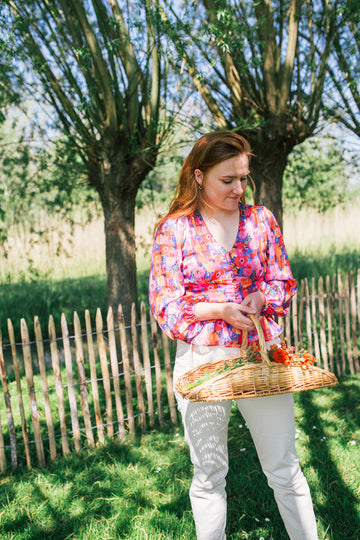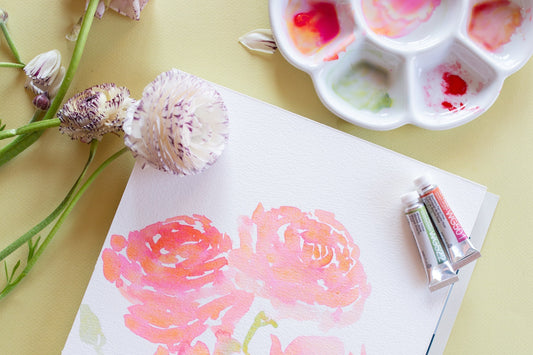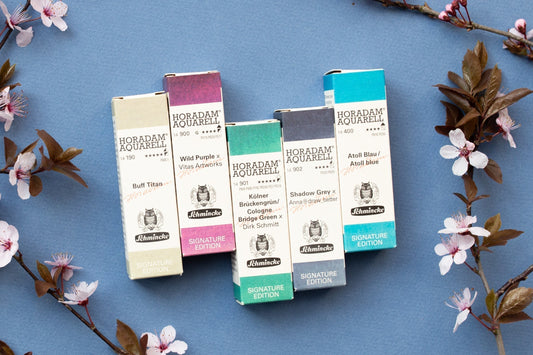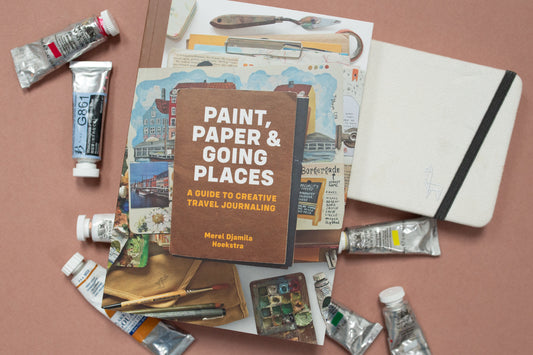Do you also see beautiful hand lettering, made with brush pens? These pens may look a little intimidating, but it is not that difficult to write beautiful words with them! You also don't need many materials; a brush pen and paper is sufficient. In this blog I will tell you more about what types of brush pens there are and how you can use them.
What are brush pens?
Brush pens are pens with a pointed, flexible tip. These points are very sensitive to pressure, so you can make nice differences in line widths. For example, you exert a lot of pressure with downstrokes (lines down) and little with upstrokes (lines up). Lettering with brush pens is a nice step between faux calligraphy (you first write the word with a fineliner, for example, and then make the downstrokes thicker by drawing the lines down again) and calligraphy with a dip pen. You'll learn how to make different line thicknesses with brush lettering very well. Once you have mastered brush lettering, the switch to calligraphy with a dip pen will also be a lot smaller!


What's the difference between a brush and a brush pen?
Brush lettering can be done with brushes, but also with brush pens. With a brush you have to pick up the ink or paint yourself, with a brushpen the ink is already there. Brushes are often more flexible than brush pens, so they fan out more. With brushes you have more freedom in the choice of ink or paint that you will use. For example, you can work with gouache or watercolor (Finetec gives very nice effects!). You can also choose from many different thicknesses and types of hair with brushes. With brush pens you are dependent on the colors that the different brands offer.
Besides regular brushes, there are also waterbrushes. These pens have a water reservoir and can be used with your favorite paint or ink. Before use, fill this reservoir with water and tighten the brush well so that it doesn't leak. Then you use the waterbrush by squeezing the reservoir, so that water comes out of the pen. This allows you to determine how much water you use. The brushes are made of a nice quality nylon that keeps its shape well.
Brush pens offer you more convenience than brushes, because the ink is already in the pen. That is why they are also nice and easy to take with you if, for example, you go somewhere for a day or if you want to learn more on holiday!
Differences in brush tips
There are a number of properties that distinguish brush pens from each other. The material of the brush tip is one of them. There are brush pens with brush hair tips, such as the Pentel Color Brush Pen, but also brush pens with a felt tip (Ecoline, Artline Stix, Tombow ABT). The felt pens are generally a bit firmer and you have a bit more control over how consistent your lines are.
In addition, points often also vary from hard to soft. Soft brush tips (such as those from Ecoline or Tombow) are often more difficult for a beginner to work with, because they are very flexible. On the Pentel Touch and the Tombow Fudenosuke, for example, you have to press a little harder while writing, because they are less flexible. This gives you more control over your letters and makes it easier to make both thin and thick lines. If you are just starting out with brush lettering, these are good pens to try.
Finally, the size of the point can also influence how your letters look. If you want to write big, you better use an Ecoline brushpen or a Tombow ABT, because both have a large and wide point. For finer work, a small tip like the Pentel Touch or Tombow Fudenosuke is very suitable. This allows you to work very detailed.
Types of inkt
In addition to the brush tip, you also have to take the ink in it into account. Most of the ink in brush pens is water-based. This means that you can easily blend them with each other (which gives nice effects!) And that you can use them on almost all types of paper. With blending you mix two different colors with each other. Since the ink is water soluble, you can blend the two colors with a wet brush or blender.
All brush pens in my shop are water-based, but there are also pens that are alcohol-based. If you are not using marker paper, these will press right through your paper. If you want to blend your brush pens with water, I also recommend using thicker paper, for example watercolor paper. Then your work will remain beautiful! Brush pens that are suitable for blending are those of Ecoline, the Pentel Touch, the Artline Stix and the Tombow ABT. You can blend the Ecoline brush pens with each other, but also combine them with the old-fashioned ink in the jars. Here you can create beautiful ombre effects!
I have already tested a number of different brush pens for you in an earlier blog post, including the ones I mentioned above. Curious? You can read it here!
What paper can I use?
For brush pens with a soft, felt tip (Ecoline, Tombow ABT) it is best to use Bristol papier. This paper has a smooth surface and ensures that your letters look beautiful, but also that your point remains beautifully in tact. Printer paper is very rough, so the tip of your brushpen will quickly spread apart and become less sharp. That's, of course, a waste of your beautiful brush pens! Are you looking for a slightly cheaper alternative to practice? Then I'd recommend the Blocks from Rhodia. These are available with blank paper, lines, squares or dots.


How to use a brush pen?
Hold your pen at an angle of about 45 degrees. It works best to hold the pen close to the tip. This gives you enough control over the point and the letters you are going to write. In addition, writing is smoother if you use your entire arm for your movement instead of just your wrist. Experiment with holding your pen in different places, it might work better for you to hold the pen a little further from the nib!
When brushing you make differences in the thickness of the lines by alternately exerting more and less pressure on your brushpen. When you write a line up (upstrokes), you apply less pressure than when you write a line down (downstrokes). This gives you that nice variation in thickness. With downstrokes it is not necessary to press very hard on your marker. If you do this, your nib will wear out faster. Most brushpens bounce easily, even if they have a hard point.
It is always nice to practice with upstrokes, downstrokes and loops before you really start writing. You will soon notice that the lettering is much smoother and the result is even better! As a beginner, it can be useful to start practicing individual letters when you really start writing letters. Once you've got the hang of this, you can start practicing connecting the letters. Good words to practice are "minimum" and "aluminum". It contains many upstrokes, downstrokes and also a number of loops. In addition, you can also find many worksheets on the internet with exercises and letters that you can trace. This really helps you to learn and practice new fonts! Would you like to have some examples? Then I have a number of nice books in my shop that can help you on your way. 'Color! Brush lettering for everyone' by Carla Kamphuis is a very inspiring book about brush lettering from which you can get many different techniques!
Enjoy it!
Brush pens can be a bit intimidating at first. Maybe the pen you're using just isn't quite right for the way you work. That's not bad at all! Try out different types of pens to find out which one suits you best. Writing should be fun! Also, don't worry too much about writing the perfect letter. The nice thing about brush lettering is the variation in the letters and that it doesn't have to be perfect at all. That keeps it playful! This gives you a lot of freedom to do what you like. So try all kinds of techniques and keep practicing!
Love,
Judith
